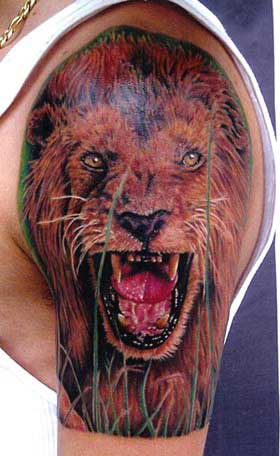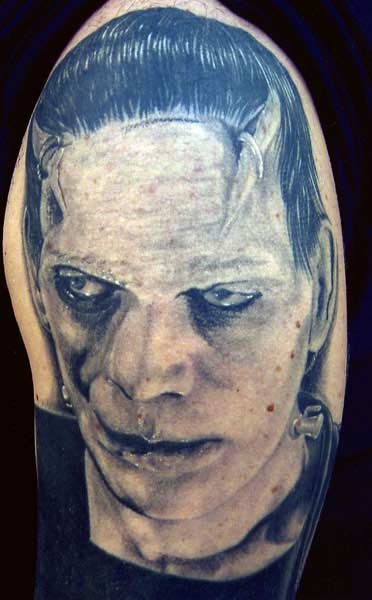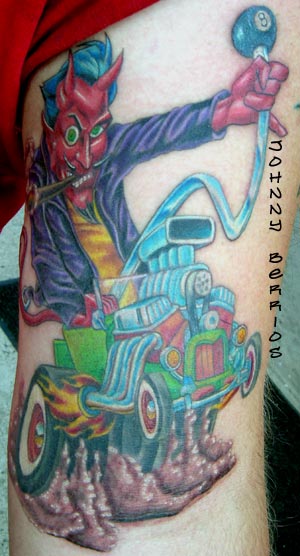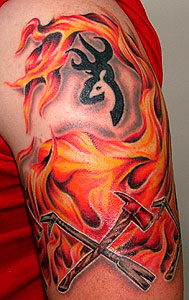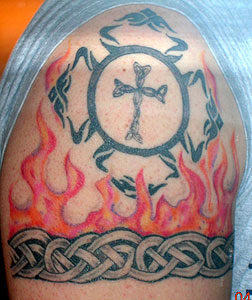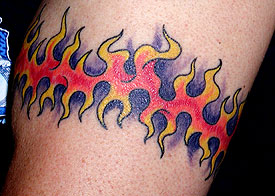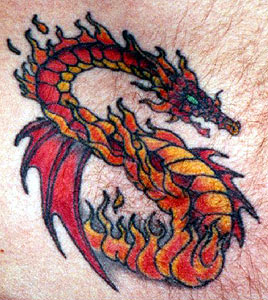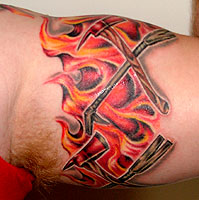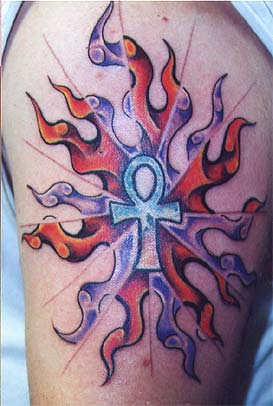29 Jul '03 -
Tattoo History - Prison Tattoos
Kijk aan! U bent nèt op tijd voor Dreadloki & Haida's Dinsdag Tatoeage-dag! U weet wel, die ene themadag waarbij alle andere verbleken. Vandaag slaan we u om de oren met een boel informatie over .... Prison Tattoos.

History
Dit is lastig. Het valt vrij moeilijk te achterhalen wanneer exact het vrijwillig tatoeëren binnen het gevangeniswezen plaatsvond. Dat er gevangenen geheel onvrijwillig getatoeëerd werden in de 2e Wereldoorlog is iedereen nagenoeg bekend. Dientengevolge beperken we ons vandaag dan ook tot de cultuur die we allen kennen. De Amerikaanse gevangeniscultuur.
Tats, Tacs or Ink, whatever slang term you use to describe tattoos there’s one thing you can’t get around. Tattoo recognition and interpretation is a valuable tool when dealing with state prison parolees. A convict’s ink will tell you three sweet pieces of info about him.Who he is, what he’s done and where he’s been. Lets first talk about joint tats in general.
Joint ink starts out as one color. Blue. It may turn black or purple according to the sun and the skin pigment but it usually starts out blue. If you see other colors besides blue, or it’s variations, the tat probably is not a true joint tat. There are two ways of giving a tat. Free hand, which most are, or machine. Free hands a no brainer. You get some ink, usually out of a pen, and you dip a needle, usually a straight pen, and you use the Polynesian method. That is a series of dots to form a picture or word. These tats are crude and sloppy and very noticeable. The second method is the machine. A home made tat machine consists of a slot car motor, a hollowed out ball point pin, some guitar string and a 9 volt battery. Oh ya and the ink. The hollowed out pen is wired or taped to the motor facing away from it. The guitar string is wrapped around the arm of the motor and run through the pen so it sticks out about a 16th of an inch out the end. Hook up a flashlight battery and its tat time. When the battery is hooked up, the motor arm vibrates which moves the guitar string back and forth rapidly in and out of the end of the pen and as long as you keep dipping the end in the ink, you can create a tattoo. Machine ink jobs are more detailed because of the method but also because they are usually done with stencils. Getting caught giving a tat or getting one in the joint is a serious crono. You remember, a 115. A write up. It spreads decease inside the institution.
OK, lets talk about the three things the ink tells you. First of all, who he is. Many times the convict will have his name or street name on him. I have even heard of having one’s CDC # put on. Also a loved ones name may help you ID him. What he’s done often relates to his crimes. For example if he carries a gun, a picture of the weapon maybe on him. If the gun is pictured from the side this means he carries a gun. If the weapon is pointed outward, this means he is a shooter. Where he’s been has to do with the joints he has called home. The ink in relation to the joints he’s been in will be landmarks. Landmarks such as walls, gun towers, cell doors or windows and bob wire. Remember to take your time and read the ink.

Tattoos and their Meaning
Clock faces without hands............................. ..Doing time
Tombstones with numbers on them................The years they were inside
Tombstones with numbers and RIP................Mourning the death of a friend
Spider/cobb webs on elbows/shoulders........Doing time
Eight balls...................................................Behind the eight ball or bad luck
One laughing face/one crying face........Play now, pay later or my happy life, my sad life
SWP......................................................................Supreme white power
Peckerwood.........................................................White pride ( males )
Featherwood........................................................White pride ( females )
Viking themes.......................................................Common Caucasian tat
Granite block walls..............................................Time in Old Folsom Prison
100 % pure............................................................Pure white or anglo
Cell window with sun or bird showing.............Waiting to get out
Face of female crying..................................Has someone on the outside waiting
SUR.........................................................................Southerner
Norteano................................................................Northerner
Prison block wall with bricks falling outward...Inside wanting to get out

Gangs
Ook dit valt moeilijk samen te vatten, aangezien er héél véél gangs zijn en nog meerdere spinoffs. We benoemen de zes grootste en waar mogelijk de gerelateerde bendes.
Aryan Brotherhood
Gender Makeup: Male
Racial Makeup: White
Origin: Originated in 1967 in the San Quentin State Prison, California Department of Corrections.
Characteristics: Unaffiliated splinter groups sometimes use the name of their state along with the name "Aryan Brotherhood" (e.g., Aryan Brotherhood of Texas).
Members display many white supremacist, neo-nazi characteristics and ideology, but often state their goals as simply "getting high and getting over," or making their stay in the prison as comfortable as possible.
Members are ordinarily apolitical. Most are in custody for crimes such as robbery.
Identifiers/Symbols: Shamrock clover leaf , Initials "AB", Swastikas, Double lighting bolts, The numbers "666", Known to use Gaelic (old Irish) symbols as a method of coding communications. Aryan Brotherhood groups from other states often accompany the symbols mentioned above with the name of the state.
Enemies/Rivals: The AB maintains a working relationship with the Mexican Mafia (EME) and therefore opposes the EME's long-time enemy, the La Nuestra Familia (NF).
The Aryan Brotherhood has traditionally nurtured a deep hatred toward black individuals and members of black groups/gangs, such as the:
Black Guerrilla Family (BGF), Crips, Bloods, El Rukns
Allies: Maintains a working relationship with the Mexican Mafia (EME).
Is known to give moral support to black groups in an effort to encourage possible prison disturbances.
Utilizes black associates to buy and sell drugs to elements of the black prison population.
Compatibles with most motorcycle gangs; many members were former "Bikers."
Compatible with most white supremacy groups. This often leads to confusion in distinguishing AB members from other white supremacist groups, particularly when making identification by their tattoos or symbols. "Copy cat" Aryan Brotherhood groups are generally tolerated by true members. However, federal and California ABs do not consider them to be legitimate and may threaten violence if AB tattoos are not burned or cut off.
Actively cooperates with the Dirty White Boys, an Anglo spin-off gang of the Texas Syndicate. Similar cooperation has been observed with the Silent Brotherhood.
Recruitment/Initiation: Membership in the AB has traditionally come from white male inmates. Lifelong allegiance is a requirement. A "Blood in, blood out" oath must be taken.
Often a "hit" or significant act of violence is required before full membership is earned.
Candidacy for membership may last a year or more.

Propensity for Disruptive Behavior: Aryan Brotherhood is not readily recognizable; however, receipt of inmates on interstate compact and the current membership in groups with white supremacy ideology lend to the threat of an organizing AB within our facilities. Main activities of the AB are centered on drug trafficking, extortion, pressure rackets, and internal discipline. Prison activities include introduction of contraband, distribution of drugs, and getting past facility rules and regulations. Traditionally, targets have been non-gang inmates and internal discipline. From 1975 to 1985, members committed 40 homicides in California prisons and local jails, as well as 13 homicides in the community. From 1978 to 1992, AB members, suspects, and associates in the federal system were involved in 26 homicides, 3 of which involved staff victims. Once released from custody, AB members are actively expected to continue to assist or "score" for the members remaining in prison.
Links/gerelateerd:
Nazi Low Riders
http://www.adl.org/hate_symbols/tattoo_aryan_brotherhood.asp
http://www.academon.com/lib/paper/16318.html
http://www.knowgangs.com/gang_resources/aryan_brotherhood/ab_001.htm
http://www.adc.state.az.us/STG/AAB.htm
http://www.shutitdown.net/gangtattoos/
http://www.lex4.k12.sc.us/shs/departments/English/symbols%20of%20hate.html
http://www.dc.state.fl.us/pub/gangs/racial.html
Neta
Gender Makeup: Male
Racial Makeup: Puerto Rican-American/ Hispanic
Origin: an inmate established The Neta in 1970 in Rio Pedras Prison, Puerto Rico. It was formed to stop the violence between inmates housed in the Rio Pedras Prison. Characteristics: They use the facade of a cultural organization. They are establishing ties to street gangs. Members are strongly patriotic and have associated themselves with a revolutionary Puerto Rican group called the Los Macheteros. Their philosophy is "independence for the island" or "Puerto Rico." They see themselves as oppressed people who are unwillingly to be governed by the United States. Members are required to procure 20 perspective recruits. Any disrespect shown to an individual Neta member is looked upon as disrespect to the group and is usually dealt with violently. Neta members come together in observance of their fallen members on the 30th of each month.
Identifiers/Symbols: Their colors are red, white, and blue. There is also evidence that black is sometimes substituted for blue. Members usually wear beads in these colors, but also will wear clothing such as bandannas, handkerchiefs sticking out of their pockets, white tops, black shorts, etc., in these colors. Probationary members wear all white beads until they are considered loyal; then, they can wear black beads among the white, plus one red one.
Members usually display the Puerto Rican flag and are known to carry Neta identification cards. The Neta emblem is a heart pierced by two crossing Puerto Rican flags with a shackled right hand with the middle and index fingers crossed. Members salute each other by holding the crossed fingers of their right hand over their heart. This hand signal has the meaning "N" in sign language; it also means togetherness and unity.
Enemies/Rivals: Latin Kings, Los Solidos
Neta members are secretive and will not freely admit membership. This group is much more challenging to identify and validate than other gangs.

Propensity for Disruptive Behavior: A classic Neta tactic is to keep a low profile while other Hispanic groups draw attention to themselves. They have quietly entrenched themselves in the drug trade and extortion, and have performed "hits" for other STGs. Neta is actively recruiting members in our correctional facilities. Neta's growth should be closely monitored in prisons and they should never be taken lightly. Neta is dangerous to staff and inmates. Drug activity, extortion, and gang-related violence are what they do and they do it violently. They like to carry semiautomatic and fully automatic weapons. Neta members are not deterred by police and will not hesitate to attack or to kill one if they feel it is necessary.
Black Guerrilla Family (BGF)
Gender Makeup: Male
Racial Makeup: Black
Origin: Founded in 1966 at San Quentin State Prison, California by former Black Panther member George L. Jackson.
Characteristics: The BGF is the most politically oriented of the major prison gangs.
They were formed as a Marxist/Maoist/Leninist revolutionary organization with these goals:
Eradicate racism. Struggle to maintain dignity in prison. Overthrow the United States government. The group is extremely antigovernment and anti-official. This mentality is often depicted in their symbolism. BGF has a very strict death oath that requires a life pledge of loyalty to the group.
Identifiers/symbols: Antigovernment/anti-official mentality is often depicted in conjunction with the initials BGF. Cross sabers and shotgun. Black dragon overtaking a prison or prison tower.
Enemies/Rivals: Aryan Brotherhood, Texas Syndicate, Aryan Brotherhood of Texas, Mexican Mafia
Allies: Has a very active working relationship with La Nuestra Familia.
Other allies: Black Liberation Army, Symbionese Liberation Army, Weather Underground
black street gangs. Black street gangs are often utilized by the BGF and their members are heavily recruited into the BGF.
These include: Crips, Bloods, El Rukns, Black Gangster Disciples, other black street gangs
Recruitment/Initiation:
Membership in the BGF has traditionally come from black male inmates. Lifelong allegiance is a requirement and a death oath must be taken. Black street gang members are often recruited into the BGF upon imprisonment.

Propensity for Disruptive Behavior:
The BGF is not readily recognizable in the Florida Department of Corrections; however the history of the group and documented acts of violence in other jurisdictions warrants their certification as a Security Threat Group. Receipt of inmates on interstate compact lend to the potential threat of an organizing BGF within our facilities. The antigovernment, anti-official mentality promoted by the group poses a serious threat to corrections and law enforcement personnel who represent the government and the law.
Mexican Mafia
Gender Makeup: Male
Racial Makeup: Mexican-American/Hispanic
Origin: The Mexican Mafia (EME) was formed in the late 50s at Duel Vocational Center, a youthful offender facility in California, from an urban Los Angeles street gang. Characteristics: EME's philosophy centers on ethnic solidarity and control of drug trafficking. EME is the Federal Bureau of Prisons' most active gang, in terms of incident frequency rather than severity. Ordinarily, each prison has a separate leadership.
Identifiers/Symbols: Initials "EME." The Mexican flag symbols such as the eagle with a snake in conjunction with the initials "EME." A single hand print, usually black in color.
The EME symbol of eternal war. Initials 'MM' or 'M.'
Many intelligence personnel and officers confuse the EME with the Mexikanemi from Texas. Great care should be taken in evaluating these distinct groups. Some believe the Mexikanemi share identical tattoos and symbols with EME, but there are subtle differences to be taken into account when attempting to associate membership.
Enemies/Rivals: The La Nuestra Familia is the EME's chief rival. They are said to have a "kill on sight relationship," which has resulted in Federal Bureau of Prisons adopting an absolute separation of confirmed members.
Other rivals include: Northern Structure, Arizona's New Mexican Mafia, Black Guerrilla Family, black street gangs
Allies: The EME has a very active working relationship with the Aryan Brotherhood. Other allies include: Arizona's Old Mexican Mafia, Mexikanemi, New Mexico Syndicate, urban Latino street gangs.
The EME often provides protection for imprisoned La Costa Nostra members. Recruitment/Initiation: Members are Mexican-American/Hispanic male inmates.
The wives, girlfriends, and relatives of the EME are held in extremely high regard due to their support of drug transactions, financial activities, and mail-forwarding operations.
The EME is generally considered a "blood in, blood out" organization.

Propensity for Disruptive Behavior: EME is not readily recognizable in the Florida Department of Corrections; however the history of the group and documented acts of violence in other jurisdictions warrants STG certification.
Receipt of inmates on interstate compact and the current membership in groups with Hispanic/Latino supremacy ideology and Latino street gangs lend to the threat.
The main activities of the EME are centered around drug trafficking, extortion, pressure rackets, and internal discipline. The EME uses killing as a means of discipline or gaining respect. EME killings are extremely gruesome and calculated to establish fear and intimidation.
La Nuestra Familia
Gender Makeup: Male
Racial Makeup: Mexican-American/ Hispanic
Origin: The La Nuestra Familia (NF) originated in Soledad prison in California in the mid 60s. It was established to protect younger, rural, Mexican-American inmates from other inmates. Characteristics: The NF was originally formed for protection purposes from the Mexican Mafia (EME). The cultural and social differences between urban and rural Mexican Americans developed into a deep hatred between the EME and NF. The struggle to gain power over other groups evolved into the NF's participation in criminal activities in an effort to control the introduction of contraband into the facilities. There are separate organizational chains for street and prison segments.
Identifiers/Symbols: La Nuestra Familia members are known to wear identifying red rags (as does the Northern Structure). NF members favor larger tattoos, often on the entire back.
Symbols include the initials NF, LNF, ENE, and F. The number 14 for "N," the 14th letter in the alphabet stands for Norte or Northern California. A sombrero with a dagger is a symbol commonly used by NF members.
Enemies/Rivals: The Mexican Mafia is the chief rival.
Other rivals include: Texas Syndicate, Mexikanemi, F-14s, Aryan Brotherhood
Allies: The NFs have an uneasy working relationship with the Black Guerrilla Family that is driven by their sharing of common enemies. The Northern Structure, a spin-off subsidiary prison gang, is believed to have formed to direct the attention of officials away from the NF.
Recruitment/Initiation: Membership consists traditionally of Mexican-American/Hispanic male inmates. Lifelong allegiance is a requirement and a "blood in, blood out" oath must be taken. Membership appears to extend beyond prison.

Propensity for Disruptive Behavior: The NF is not readily recognizable in the Florida Department of Corrections; however the history of the group and documented acts of violence in other jurisdictions warrants their STG certification. Receipt of inmates on interstate compact and the current membership in groups with Hispanic and Latino supremacy ideology lend to the threat of an organizing NF within our facilities.
Their main activities are drug trafficking, extortion, pressure rackets, and internal discipline.
Once released from custody NF members are expected to actively continue to assist or "score" for the members remaining in prison. Failure to do so can cause a member to fall in great disfavor with other members.
Links/gerelateerd:
Met alle onderlinge intriges valt het moeilijk uit te vinden wie precies een hekel heeft aan wie. Daarbij is het niet ongewoon dat, mits het uitkomt, er steun aan een bepaalde groep wordt verleent om vervolgens doodleuk diezelfde groepering te verraden. Puur en alleen omdat dit goed uitkomt. Een beetje zoals onze hedendaagse politiek dus. Dus voor het gemak staan hieronder alle 'Hispanic' links.
Barrio Azteca
http://www.eboards4all.com/604375/messages/2448.html
http://www.segag.org/frpistol.html
http://www.tattoomaniastudio.com/ta2/ta2arte.html
Old Mexican Mafia
http://www.adc.state.az.us/STG/OMM.htm
New Mexico Syndicate
Gangbusters.com
Texas Syndicate (TS)
Gender Makeup: Male
Racial Makeup: Mexican-American/ Hispanic
Origin: The TS originated in Folsom prison, in California in the early 70s.
It was established in direct response to the other California prison gangs (notably the Aryan Brotherhood and Mexican Mafia), which were attempting to prey on native Texas inmates.
Characteristics: Membership is rising nationally due to recruitment. The TS now accepts members from Latin American countries such as Columbia, Cuba, and Mexico. They have made attempts to recruit in the Florida Department of Corrections. A TS member is called a "Carnal." A group of members is called "Carnales." A TS recruit is called a "Cardinal." The institutional leader is called the "Chairman."
Identifiers/Symbols: They have tattoos with a "TS" located somewhere in the design; sometimes requires close scrutiny. The tattoos are generally located on the back of the right forearm, but they have also been found on the outside calf areas, neck, and chest.
Enemies/Rivals: Aryan Brotherhood, La Nuestra Familia, Mexican Mafia, Mexikanemi, Mandingo Warriors.
Allies: The TS has developed associations with the Texas Mafia and Dirty White Boys.

Propensity for Disruptive Behavior: There is some representation in the Florida Department of Corrections. The TS has been found to be recruiting. The history of the group and documented acts of violence in other jurisdictions warrant their certification as a Security Threat Group. Receipt of inmates on interstate compact and the current membership in groups with Hispanic and Latino supremacy ideology lend to the threat of an organizing TS within our facilities. The main activities of the TS are centered around drug trafficking, extortion, pressure rackets, and internal discipline.
De andere kant
Op dit moment worden er vele initatieven genomen om ex-bajesklanten/gangmembers weer een plek te bezorgen in de 'normale' maatschappij. Dus de meest logische stap is het verwijderen van de gang-tatoeages middels laserbehandelingen.
http://www.co.fairfax.va.us/service/skindeep/homepage.htm
http://www.geocities.com/~gangoutreach/
http://www.metroactive.com/papers/metro/02.13.97/tattoo1-9707.html
http://www.tyc.state.tx.us/archive/Media/031099_unmarked.html
http://www.thekidsshow.org/issues/kidslaw_gangs.shtml
http://abcnews.go.com/sections/living/DailyNews/tattooremoval001017.html
Achtergrond
Vele gang-tatoeages zijn gebaseerd op religieuze afbeeldingen. De uiteenlopende meningen daarover kunt u hieronder vinden.
Christenen
http://www.axxent.ca/~gennaro/
http://www.axxent.ca/~gennaro/Bible_Support/index.html
http://salc.wsu.edu/Fair_F02/FS3/Psychology/religion.htm
http://www.axxent.ca/~gennaro/Tattoo_History/
http://www.axxent.ca/~gennaro/Other_Tattoos/index.html
http://www.dreamlandcreations.net/myke/tattoos/tattoo_gallery_c=10.html
http://sealofthelivinggod.com/index5.html
http://sealofthelivinggod.com/sealtatphotos1.html
http://christianteens.about.com/library/weekly/aa010501a.htm
Islam
http://www.answering-christianity.com/tattoos.htm
Joods
http://www.geocities.com/mnlerner2000/
Los spul
http://photoarts.com/journal/SABA/kenlight/tear.html
http://www.tattoo-designs.ws/prison.html
http://www.cnn.com/US/9902/18/dragging.death.03/
http://memory.loc.gov/pnp/fsa/8b15000/8b15500/8b15572r.jpg
http://photoswest.org/cgi-bin/imager?00185557+Rh-557
Alle gangs
http://www.convictsandcops.com/tattoo.htm
http://www.foto8.com/issue01/dprisontattoos/prisontattoos1.html
http://www.foto8.com/issue01/dprisontattoos/prisontattoos2.html
http://www.foto8.com/issue01/dprisontattoos/prisontattoos3.html
http://www.cellblockvisions.com/artgallery4.html
http://www.nevadacorrections.org/gangs.html
http://www.dc.state.fl.us/pub/gangs/prison.html
http://www.thebackup.com/trainingacademy/gangs/gt_tattoos.asp
http://www.landmarkcases.org/tinker/gangs.html
http://www.gangsorus.com/otherprison.html
http://www.geocities.com/inmatestory/gang/tattoo.htm
http://www.cjconsultant.com/pgangs.htm
http://www.nagia.org/east_coast_mexican_gangs.htm
http://www.adc.state.az.us/STG/Tattoos.htm
http://www.freeessays.cc/db/43/svn280.shtml
Extra! Russian Tattoos!
The tattoos are painfully applied with needles and electric shavers, using ink made from urine, soot, and shampoo. Infection from the procedure is frequent, and death not uncommon.

Monasteries, cathedrals, castles, and fortresses are often tattooed on the chest, back, or hand. The number of spires or towers can represent the years a prisoner has been incarcerated, or number of times they have been imprisoned. The phrase, "The Church is the House of God," often inscribed beneath a cathedral, has the metaphorical meaning, "Prison is the Home of the Thief."
A spider or spider's web symbolizes drug addiction.
Links
http://russian.4t.com/
http://www.mgia.org/assets/pdf/RUSSIAN1.PDF (large)
http://www.mgia.org/assets/pdf/RUSSIAN2.PDF (large)
Tattoolog!
23 hadden wat:
Het is weer een mooi en uitgebreid stukje tekst :) Wat ook interessant is trouwens, is het ‘prison tattoo cultuurtje’ in Rusland. Hier ene link: http://www.vanishingtattoo.com/china_rus.. (‘Today, prison tattoos constitute a secret language, but in wartime gulags, tattoos were a form of protest.’)




